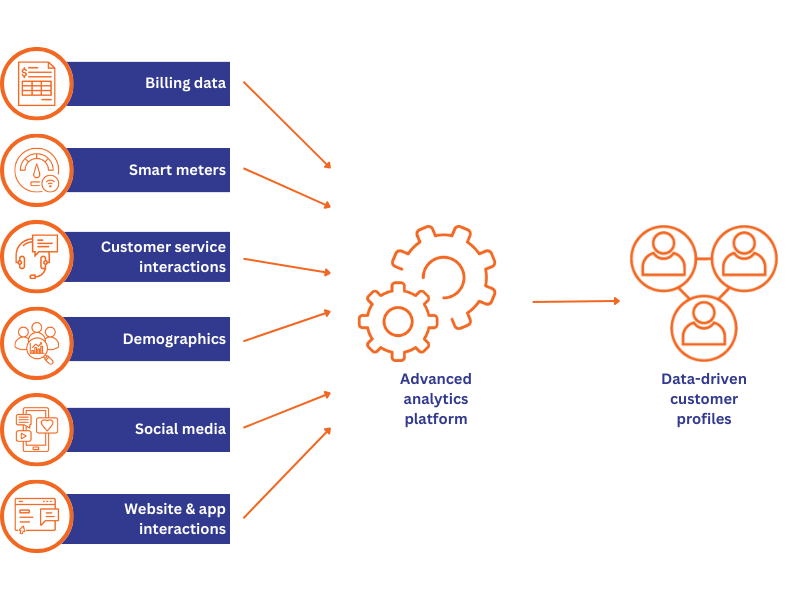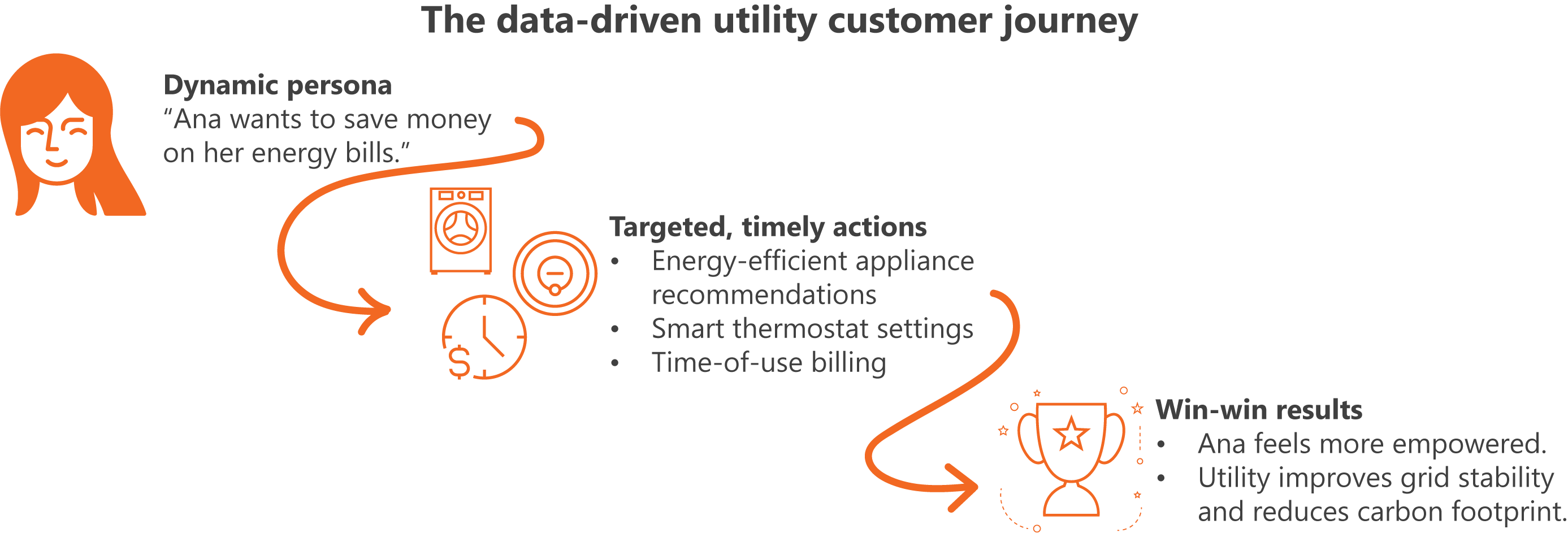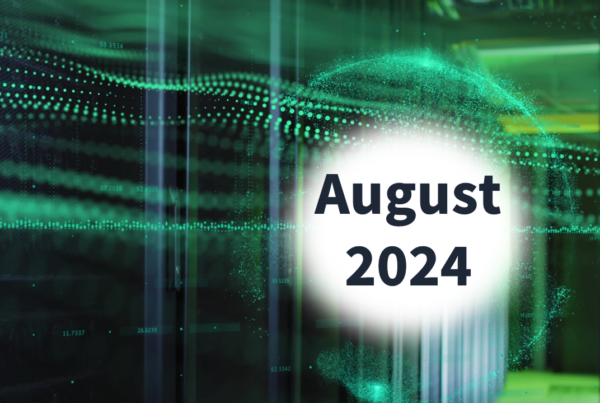
Today’s utilities industry landscape demands a deeper understanding of customers, and data is the key! By embracing a modernized data-driven customer experience, utilities can reveal powerful insights and forge meaningful connections with their customers on a personal basis.
Implementing advanced analytics to diverse data sources — spanning smart meter readings to social media interactions — enables utilities to construct detailed customer personas and curate hyper-personalized experiences that speak to their customized needs and preferences. Increasingly personal experiences not only boost customer satisfaction but also fuel change initiatives including promoting energy efficiency and encouraging the adoption of renewable technologies.
Optimized data management lays the groundwork for proactive compliance with current and future regulations, reducing risk and ensuring business continuity. Embracing data-driven customer engagement also enables utilities to realize new growth opportunities, strengthen customer relationships, and pave the way for a compliant, sustainable, and successful future.
 The power of data diversity
The power of data diversity
Utility providers have traditionally relied on billing data and static demographics for the insights that drive customer engagement. Today’s innovative utilities can forge new paths by harnessing a diverse spectrum of data sources including:
- Smart meters provide real-time insights into consumption patterns, revealing peak energy usage periods and opportunities for targeted interventions.
- Customer interactions via phone, email, and online channels offer valuable qualitative data, shedding light on pain points, aspirations, and environmental concerns.
- Even seemingly unconventional sources like social media activity can identify key trends and segment demographics based on online behaviors.
By tapping into these diverse data streams and applying advanced analytics, utilities can paint a more comprehensive picture of their customer base, enabling an evolution from static archetypes to dynamic personas and laying the foundation for truly impactful customer journeys.
Utilities can analyze individual preferences and consumption patterns to deliver targeted communications that resonate with each customer segment—like promoting energy-saving tips during peak periods to high-consumption households or recommending energy-efficient appliances to customers asking about sustainability. These hyper-personalized interventions enhance customer satisfaction while driving tangible results, improving efficiency, and contributing to a more sustainable, profitable future for the utility.
Precise personas, targeted journeys
Personalized journeys can go beyond passive communication and actively influence customer behaviors. Consider “Ana,” a customer who has called to complain about high energy bills. By analyzing Ana’s consumption patterns and preferences, the utility can design a targeted behavioral nudge campaign that might involve:
- Personalized recommendations for energy-efficient appliances.
- Smart thermostat settings.
- Participation in time-of-use programs.
By providing relevant “nudges” at the right moments, Ana’s utility delivers the tools she needs to make informed choices, optimize her energy consumption, and ultimately realize cost savings. Not only does Ana gain a sense of control and empowerment, but the utility contributes to overall grid stability and carbon footprint reduction, thus aligning individual customer and general sustainability goals.
 Embracing change
Embracing change
Influencing customer behaviors also requires navigating the human element of change and fostering genuine buy-in. Utilities often face resistance to new initiatives such as time-of-use (TOU) programs. Successfully implementing these programs hinges on employing effective change management strategies that address concerns, build trust, and incentivize participation.
Consider the following scenario. The fictional utility “Tinyville Power & Light (TP&L)” is introducing a voluntary TOU program with incentives to shift energy consumption away from peak hours. While some customers readily embrace the program, others harbor concerns about potential inconveniences or cost increases. To address these anxieties, TP&L could leverage the following change management strategies:
Transparency and education
TP&L can launch a comprehensive information campaign through multiple channels, including personalized communications, educational webinars, and social media outreach. They can use these venues to explain the program’s benefits (cost savings, grid stability, environmental impact), respond to common concerns, and provide practical tips for adjusting energy usage during peak hours.
Pilot programs and phased rollouts
Instead of a mass rollout, TP&L can launch a pilot program with a select group of customers. This allows the utility to gather real-world feedback, refine communication strategies, and demonstrate the program’s effectiveness before wider adoption. A phased rollout also allows for adjustments to the program based on initial feedback.
Incentives
TP&L can foster a sense of engagement and reward participation through attractive incentives tied to individual customer preferences. Think loyalty points tied to energy savings or exclusive discounts on smart home devices to motivate sustained participation.
Change management strategies help utilities create a supportive environment in which customers feel informed, empowered, and motivated to take part in new initiatives. Customers enjoy enhanced individual experiences while contributing to the collective success of programs geared towards energy efficiency, sustainability, and a more resilient grid.
The use case ecosystem
Imagine leveraging smart meter data to proactively implement time-of-use programs, putting your utility ahead of regulatory curve while empowering customers to optimize their energy bills. Personalized recommendations can encourage environmentally conscious customers to explore renewable energy options like solar panels. Analyzing social media trends can help identify EV owners and tailor offerings for charging infrastructure and maintenance, paving the way for a future-proof, customer-centric grid.
Here are just a few of the additional use cases for applying advanced analytics to customer data:
Optimizing energy efficiency
Identify high-consumption households and deliver impactful nudges through personalized tips and energy-saving appliance recommendations.
Driving renewable energy adoption
Target sustainability- and cost-minded customers with tailored information and incentives for exploring solar panels or community energy programs.
Enhancing grid resilience
Predict peak demand through smart meter data and reward customer participation in demand-response programs.
Proactive regulatory compliance
Gain a data-driven understanding of regulations and tailor customer-focused initiatives to seamlessly meet future requirements, minimizing disruption and cost.
Forging fresh paths with data-driven customer engagement
In today’s dynamic utility landscape, customer understanding is the cornerstone of success. By embracing data-driven engagement, utilities can move beyond generic approaches and forge meaningful connections with each individual customer.
Through tailored journeys, informed by detailed personas and fueled by effective change management, utility providers can influence behaviors, optimize energy usage, and advance towards their sustainability goals. A data-driven foundation also ensures proactive compliance with evolving regulations, minimizing risk, and paving the way for a future-proof business model. Utilities can unlock unprecedented value, driving growth, securing loyalty, and building a thriving future for their customers.
Ben Higa is a Manager in Logic20/20’s Strategy & Operations practice.
Patricia Evanno is a Manager in Logic20/20’s Strategy & Operations practice.
Frederike Dubeau is a Senior Manager in Logic20/20’s Advanced Analytics practice.
Logic20/20 is a member of UAI.














